

WILMINGTON — The 12th District Court of Appeals has sided with local prosecutors over Clinton County Common Pleas Judge John W. “Tim” Rudduck on whether assault can be elevated to a felony when the perpetrator mistakenly hits a corrections officer.
However, it also said the state cannot retry Andrew Calhoun, who was sentenced for a misdemeanor assault charge rather than a felony one after he accidentally struck a corrections officer during a fight with another inmate.
Central to Calhoun’s sentence and to the appeal was whether accidentally striking an especially protected class of citizen when committing a crime against a non-especially-protected class can elevate a crime.
Assistant county prosecutor Matthew M. Suellentrop said that while the appeal isn’t a victory, it “is exactly what we were looking for.”
Suellentrop said Rudduck accurately said it’s a confusing area of law.
“Our goal … was that we were essentially seeking consistent application of law,” Suellentrop said. “What we want to prevent and what we want to establish is that if you’re going to engage in that kind of behavior, you’re going to suffer the consequences.”
Rudduck, however, said the 12th District Court of Appeals missed his question as to whether a person’s status can be transferred in the event of an accidental strike.
“The more protection we get for law enforcement, I’m in favor of,” Rudduck said. “But also, we don’t want people to be unjustly punished if their criminal intent was not to strike a person who was in that protected class.”
Suellentrop and Clinton County Public Defender Rob Baker said the appeal will stop now with the 12th District Court of Appeals. Baker added that he might appeal to the Ohio Supreme Court in a similar situation if his client were convicted of the felony, rather than the misdemeanor.
Evidence, including video, and court testimony showed Calhoun got into a fight while incarcerated at the Clinton County Jail.
During the fight, Betty Kindred, a corrections officer, had to physically intercede and was accidentally struck by Calhoun. In court, assistant county prosecutor Suellentrop and Kindred agreed that Calhoun didn’t intend to strike Kindred.
Prosecutors argued that Calhoun should have been found guilty of assaulting a corrections officer, a fifth-degree felony, basing their argument on the doctrine of transferred intent.
Citing several cases, the appeals court opinion, written by Judge Robert A. Hendrickson, said that under the doctrine of transferred intent “an offender who intentionally acts to harm someone but ends up accidentally harming another is criminally liable as if the offender had intended to harm the actual victim. … And the individual attempting harm is held criminally liable as if he both intended to harm and did harm the second person.”
The Clinton County Public Defender’s office, led by Baker, missed its deadline to file a brief and, because of that, was also unable to present oral arguments in support of Rudduck’s ruling.
Baker said he believes an employee in his office did file a supplemental brief.
In an interview, Baker agreed with Rudduck.
“I agree with the judge on the initial decision,” Baker said.
Baker added that the 12th District Court of Appeals has a reputation, whether earned or not, of being favorable towards prosecutors.
Rudduck, in court, disagreed with prosecutors and said the doctrine could make someone guilty of assault but couldn’t elevate the charge.
“When you look at legislative intent, why are corrections officer, why are teachers, why are these classifications of person protected more than inmates or other people out on the street?” Rudduck asked, according to Hendrickson’s opinion. “They are protected because they have a very difficult job. … When inmates are knowingly attacking [them] personally, not through a doctrine of transferred intent, higher penalties are imposed.
“But what the State wants me to do with the doctrine of transferred intent is to elevate the crime based upon that status,” Rudduck continued. “You can’t have it both ways.”
In an interview with the News Journal, Rudduck said that laws are written so that assault is typically a misdemeanor except when that assault occurs against a special status of person, such as a corrections officer. Then, it’s a felony.
“I think everyone would agree that the defendant, Mr. Calhoun, never intended to strike the corrections officer,” Rudduck said. “But for the judicially created doctrine of transferred intent, when someone attempts to strike an individual and inadvertently hits someone else, we’ve created an exception so there can be some criminal responsibility. And so we transferred the individual’s criminal intent so that that person can be found guilty of assault, which is what I did.”
Calhoun entered a plea of guilty to a misdemeanor charge of assault and received six months in prison for his sentence. That sentence ran concurrent with an eight month sentence for possession of heroin.
The 12th District Court of Appeals disagreed with a 2nd District Court of Appeals decision on a similar case, one that the opinion says Rudduck based his decision-making on.
In that case, a student accidentally struck a teacher while in a fight with another student. The 2nd District Court of Appeals said the transfer didn’t apply because the doctrine treats all victims equally, while state laws make assault on certain classes of people a felony.
“Clearly, the legislature thought that an offender who would ‘knowingly’ strike a school teacher was a more serious offender than one who would strike a student,” that court said. “We have difficulty in applying the transferred-intent doctrine to this situation wherein the victims are not treated equally under the statute.”
The 12th District Court of Appeals disagreed and pointed to the Ohio Supreme Court and the 11th District Court of Appeals, saying Calhoun should have been found as guilty as if he both intended to and did harm Kindred.
“The trial court erred as a matter of law when it refused to apply the strict liability penalty enhancement set forth in R.C. 2903.13(C)(4)(a) in conjunction with the doctrine of transferred intent,” Hendrickson wrote. “The state’s assignment of error is sustained. However … the verdict, judgment, and sentence of the trial court is affirmed as Calhoun cannot twice be put in jeopardy.”
Rudduck believes the appeals court addressed whether the status of the struck individual is also transferred.
“Intent was clear,” he said. “The fellow was never intending to strike the person that he struck.
“If he was intending to strike a corrections officer, and he ended up striking a non-corrections officer, is that a felony? … Is that a misdemeanor?” Rudduck asked. “I don’t think you transfer the status.”
Reach Nathan Kraatz at 937-382-2574, ext. 2510 or on Twitter @NathanKraatz.



